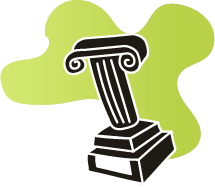Title of the resource
Title of the resource in english
Publisher
Panholzer Uitgeverij
Original language
Target and Age Group
Teachers, general public, groups interested in Classics
Link to resource
Accessed on 25 August, 2020
Author of the Entry:
Marta Pszczolińska, University of Warsaw, m.pszczolinska@al.uw.edu.pl
Peer-reviewer of the Entry:
Elżbieta Olechowska, University of Warsaw, elzbieta.olechowska@gmail.com
Second Peer-reviewer of the Entry:
Ayelet Peer, Bar- Ilan University, ayelet.peer@biu.ac.il
Magda van Tilburg
Magda van Tilburg (born in 1954) is a Dutch children’s books illustrator and graphic designer. She studied Classical Languages and Literature at the University of Amsterdam (UvA) and then attended Gerrit Rietveld Art Academy to become an illustrator.
She created a series Classica Signa published by Panholzer - black-and-white cartoons based on classical Greek and Latin texts by Homer, Euripides, Herodotus, Virgil, Ovid, or Plautus. One of them - Dido et Aeneas was displayed at the exhibition Virgil across 2000 years at the British Museum. The series was remade into colour, digitalised and published by C.C. Buchner. It is available online, renamed as Antiqua Signa. After 30 years of her career as illustrator, the author also launched a website booxalive.nl, which promotes reading and the classical languages and contains digital books with illustrations by various authors, including those inspired by Antiquity.
At the moment the author is working on an English translation of Plautus' Curculio (which on booxalive is still in Dutch) and is planning to remake Alkestis by Euripides.
source: nl.wikipedia.org, booxalive.nl (accessed: September 30, 2019)
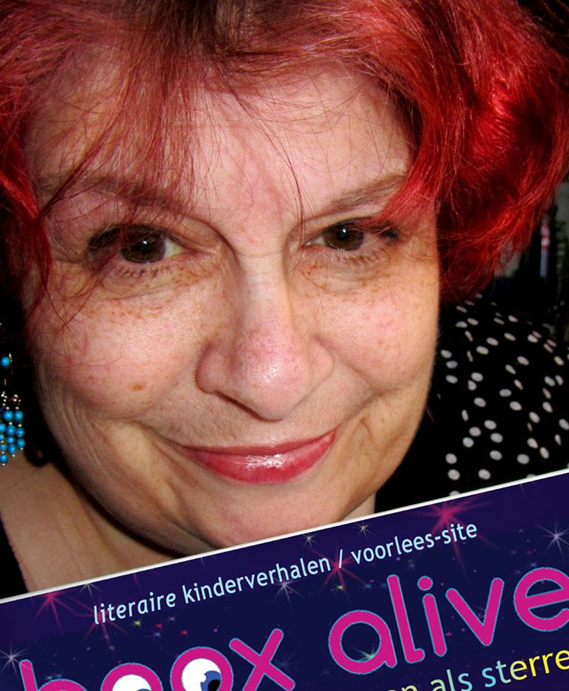
Courtesy of the Author
Questionnaire
1. Could you describe your experiences in education with Classical Antiquity?
From 1973 – 1978 I studied Classical Language and Literature at the University of Amsterdam (UvA), where I got my Bachelor Cum Laude. After that I went to the Rietveld Art Academy to become an illustrator.
Already in highschool I started to make classical graphic novels with the original ancient texts in the balloons. My first motive was, that I did not have any clue about translations. I always had a big fantasy about what the texts were saying, but in reality the texts said something else. By making drawings of what the texts really said, I could understand better what the stories were about.
With that history, after highschool I chose to study these two magnificent languages, to tame my fantasy and to teach my brain more abstract thinking.
During my university life, I extended my graphic novels to an entire series ‘Classica Signa’, with 8 titles, published by my late ex-husband (4 Latin titles/4 Greek titles).
After a 30-years career as a children's book illustrator I had to stop my studio due to chronic pain. Then I decided to create my own non-profit platform for all kinds of stories, to stimulate the modern youth to read more, and to promote Latin and Greek as fun languages with their immortal stories. So I transformed my titles to digital slideshows, with my translation in English. Now I call this series ‘Antiqua Signa’.
2. What are the language teaching methods and approaches of your choice
I don’t teach.
3. How and why do you choose your target groups?
The many classical orientated groups on Facebook are my main target, since I’m not able to do any active PR due to my health. Those groups include many teachers, and thus my work finds its way to classrooms etc.
4. Why should classical language teaching be paired with mythological education?
That’s the basis of our culture! Those immortal stories have to be kept alive!
5. How do you select the myths and cultural material to be incorporated in your works and how do you present them (do you strive for accuracy, with the cultural background of Antiquity, or do you rather contemporize their form, content or background to be relevant to the target group?)
I chose my titles from the programme I followed at the University. Before drawing each title, I try to research the original settings as well as possible (at the beginning of my work, there was no internet).
6. How do you choose the style of your illustrations that accompany the teaching material ?
I try to make my illustrations look as authentic as possible, with a touch of my own fantasy and humor.
7. Which task types do you employ to consolidate the myths?
With each digital title I also provide a section ‘Fun info’, where I explain some backgrounds of each story/myth.
8. Have you encountered any challenges in finding material on Ancient languages and culture and why do you think is important to popularize them?
I’m so very glad with the internet now and the exploding amount of old and new materials! I think nowadays more people get into mythology, because online there are no borders to get info. Also popular writers like Stephen Fry with his ‘Mythos’ and ‘Heroes’ promote the classics.
9. Are you planning any further forays into classical material?
I still have to translate 1 Latin title: Curculio by Plautus. I also have to redo the last translation, Euripides’ Alkestis. I hope this work will be done in mid-2020.
After that I hope to find a publisher who will produce 2 different volumes of novels (1 book with the 4 Latin titles/ 1 book with the 4 Greek titles).
* Much more about myself you can find on: booxalive.nl ‘in woord’ – I do hope your browser has a translation function…
* Please, feel free to take any image (covers and entire pages) from my site of the classic comic section, since my booxalive is also on a non-profit base!
* On my portfolio site you can find a survey of my children’s books from the last 30-years: magdavantilburg
Prepared by Marta Pszczolińska, University of Warsaw (m.pszczolinska@al.uw.edu.pl).
Contents & Purpose
The comic was initially created in Greek, in a black-and-white version, and then an online version in colour was introduced accompanied by an English translation. It retells the myth of Aphrodite’s affair with Ares discovered by Helios and revealed to all the gods by Hephaestus’ intrigue. The myth is known from the 8th book of The Odyssey by Homer, where the aoidos Demodocus sings it to the ruler of the Phaeacians. In the comic, however, it is Homer himself who paraphrases the incipit of The Odyssey while urging the Muse to impart the story to him.
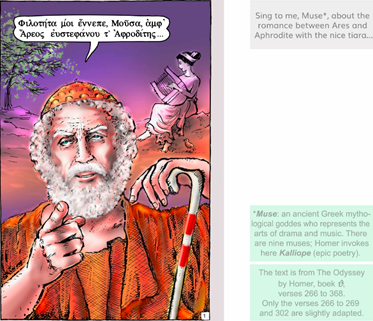
Magda van Tilburg allows the illustrated characters to speak with the words straight from the text of The Odyssey. To make the comic its own cohesive entity, rather than a story within a story delaying the narrative arc, the author slightly modifies the Homeric text. The alterations are rare - certain words are rearranged or omitted, phrases, verses, and sentences are grammatically simpler (no need to search for a predicate of a sentence from within four verses). As a result, the text ceases to be an epic hexameter and becomes a lively dialogue in the form of comic bubbles (and with comments in additional boxes).
Although the myth was sourced directly from the ancient literature, the author modernizes it, adapts it to today’s young readers and makes it more approachable providing illustrations. The topic of a love affair and infidelity caught in flagrante delicto might not be as sublime or epic as the duels of heroes of Troy, but with the witty illustrations the comic escapes vulgarities and brings the ancient lovers closer together. The theme was interpreted suggestively to connect the elements of Antiquity with modernity. The depictions of the Greek gods are quite conventional and that is why it is easy to recognise each of them individually by their attributes (thunder, trident, caduceus, corona radialis diadem, kithara, Corinthian helmet) or animals (owl). The drawings are also based on ancient works of art, such as the image of Aphrodite Kallipygos from the National Archaeological Museum in Naples (see below) or Poseidon of Melos, but every time they are enriched with modern details - expressive colours, shading, characterization of personalities with additional features, such as Poseidon’s eyebrows and facial hair in marine colours or tresses shaped like seahorses as he was god of the sea, storms, earthquakes and horses
Because of the level of difficulty of the text and the evoked eroticism, the comic is not aimed at younger children, but young adults can certainly use it to enrich the school-prescribed scope of readings from ancient texts and to see for themselves how relevant Homer can still be.
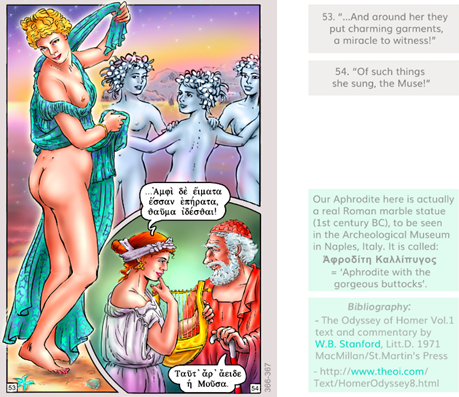
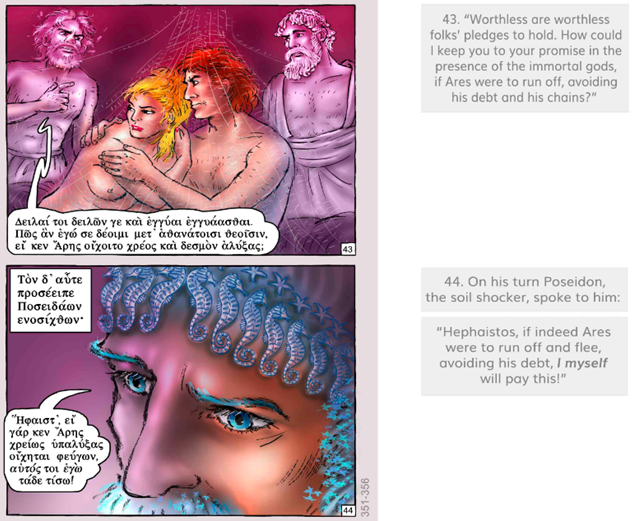
Print-screens courtesy of the Author
